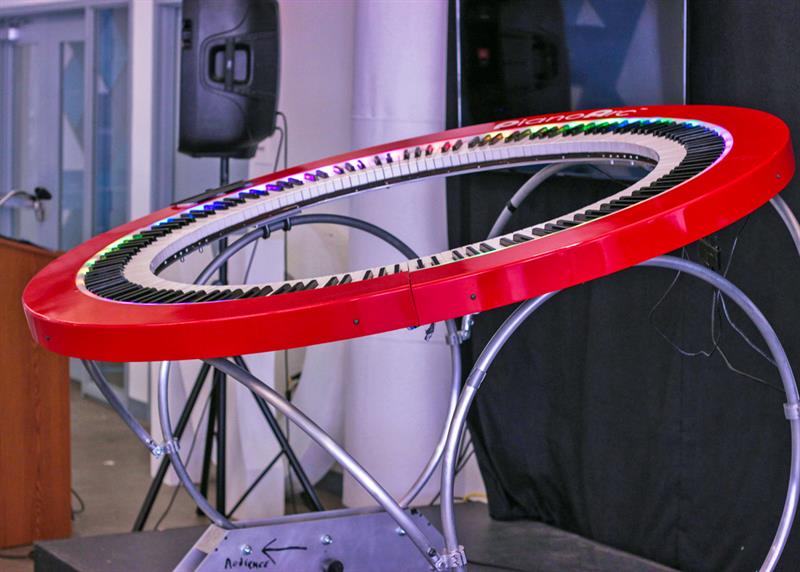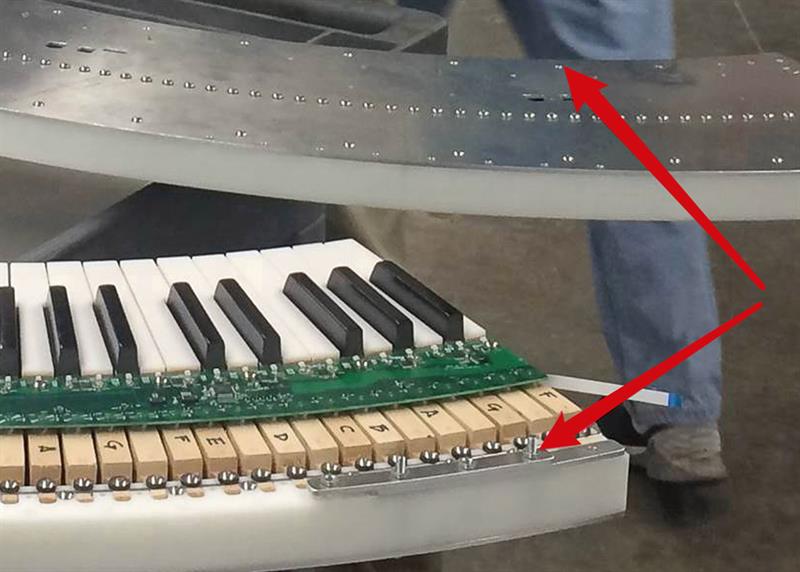One of the challenges from the outset was how to attach the keyboard to the intended stand?
“Reliable attachment between the keyboard unit and the stand is obviously essential,” says Dave Starkey, chief technical officer at PianoArc and the originator of the company’s mechanical and electronic keyboard designs.
Fixed but flexible
With any assembly, there is also the issue of disassembly, an essential function for large touring instruments.It meant designers automatically ruled out welding, adhesives and high bond tapes because of their permanent joining nature.
However, it was found alternative methods such as sheet metal screws also have their own issues that include diminished holding power, reduced thread integrity and the likelihood of loosening and falling out. As for tapping, extruding or stamping threads into a metal sheet, the sheets are generally too thin, making these joining methods impractical.
“The choice of PEM hardware does away with all the usual drawbacks associated with conventional joining technologies,” says Starkey. “Self-clinching fasteners and thin metal sheets were made for each other.”
 PianoArc’s two most popular offerings are the circular Brock360 and the semi-circular DualWing. The Brock360 – with its six-foot outerdiameter – was launched as the world’s first circular keyboard in 2012 and features sprung (unweighted) CNC machined keys and 288 contiguous notes. By comparison, the semi-circular DualWing is engineered as a dual 72-note controller keyboard that is equipped with synth action, a carbon fibre top, integrated light show, custom mounts for control surfaces, a laptop, and even a microphone mount if necessary.
PianoArc’s two most popular offerings are the circular Brock360 and the semi-circular DualWing. The Brock360 – with its six-foot outerdiameter – was launched as the world’s first circular keyboard in 2012 and features sprung (unweighted) CNC machined keys and 288 contiguous notes. By comparison, the semi-circular DualWing is engineered as a dual 72-note controller keyboard that is equipped with synth action, a carbon fibre top, integrated light show, custom mounts for control surfaces, a laptop, and even a microphone mount if necessary.
For these functions, PEM self-clinching nuts from PennEngineering became the keys to success. The nuts are permanently installed in 1/8” (3.1mm) thick machined aluminium panels – creating load-bearing threads in the sheets that provide high pushout and torque-out resistances. Then, additional mating screws complete the attachment of the keyboard units to stands. Upon installation in these applications they are manually pressed into place using an arbor press, so the fasteners ultimately remain intact, never loosening or falling out, which helps improve the ruggedness of the assembly, an essential feature for touring.
The benefits of all self-clinching fasteners effectively arises from their design incorporating an annular recess, for permanently locking the fastener in place in a thin ductile metal sheet to prevent fastener rotation while in service.

Regardless of type, self-clinching fasteners install permanently by pressing them into place in a properly sized hole and, when sufficient squeezing force is applied using a press, the fastener’s serrated clinching ring, knurl, ribs, or hex head is forced into the panel surface, displacing sheet material into a specially designed annular recess in the shank or pilot of the fastener, known as an undercut. The metal forced into the undercut secures the fastener against axial movement, while a non-rounded displacer secures it against rotation.
“No secondary operations are necessary, which has quickened our production pace,” says Starkey.
In addition, the PEM fasteners inherently reduce the number of loose parts such as washers, lock washers, and nuts that would have to be inventoried and handled.
According to Starkey, the long time experience with PEM hardware has contributed to a potentially new application now in the works.
“We’re considering mounting a Force Sensor Resistor module to our units,” he explains.
At least eight modules are planned for each piano to be installed at a printed circuit board assembly house. Instead of self-clinching fasteners – solely purposed for thin metal assemblies – PianoArc is looking to PEM ReelFast surface-mount spring-loaded captive panel screws to attach the 1.6mm PCBs.
The all-metal captive screw assemblies mount in one piece on boards using the pick-and-place method and will install in the same manner and at the same time as other surface mount components prior to the automated reflow solder processes. They are supplied on tape and reel conforming to industry standards and are compatible with existing SMT automated installation equipment.
“The captive panel screws will allow us to quick mount the modules as customer options,” says Starkey.
As for playing such a radically reconfigured instrument, Starkey says that for many performers, it can be easier than a conventional piano.
“The key dimensions where the white/black keys intersect are the same as a traditional piano,” he says. “It seems to translate easily to most keyboard techniques. The curvature actually places the natural key intervals closer together, enabling 10th intervals for many of those with a normal octave reach.”
As would likely be expected, the question most asked by performers is: ‘how do I find Middle C’?
“The latest designs include LEDs that indicate the section/channel division,” says Starkey. “By default, there are three Middle Cs in the Brock360 but it’s possible to configure up to 24.”








